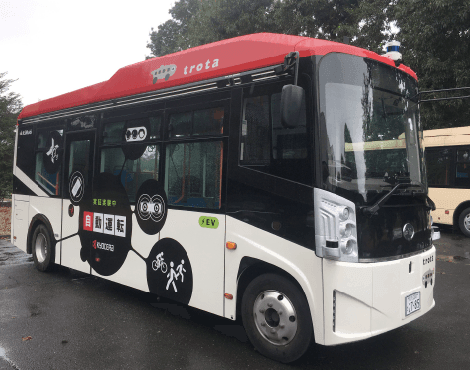

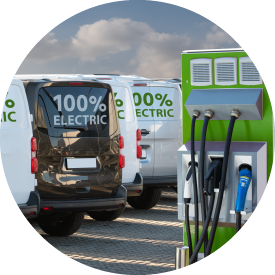
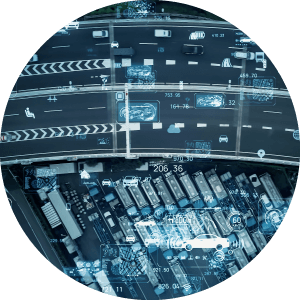


Helping Create a Safer SocietyHelping Create
a Safer Society
with I2X Roadside Units
Development Department 2 Communication
Infrastructure Systems R&D Division, R&D Group

Understanding leads to a change
in awareness about sustainable development goals
― Please tell me a little about your current work.
The Telecommunication Infrastructure System R&D Department II is tasked with developing devices that support autonomous driving. My area is the development of the Smart Road Side Units (RSUs), wireless roadside equipment for ITS*1support services, where I am in charge of software development, field tests for prototype models, on-site response for autonomous driving demonstration experiments, and analysis of the proof-of-concept test results.
* 1: ITS stands for Intelligent Transport Systems.
Smart RSUs are transportation infrastructure units that transmit vehicle positional information and traffic signal information. I2X roadside units installed at intersections collect information on traffic signals and the position and speed of nearby vehicles, which it then transmits to other drivers to support safe autonomous driving. In recent R&D focusing on autonomous driving systems, I2X roadside units have become an important transportation piece of equipment for facilitating communication between traffic infrastructure and vehicles, and between vehicles and vehicles. Kyocera is using experience gained through the development of PHP base stations and applying the technology to develop roadsite units.
― What sustainable development challenges are your department working on?
Our goal is to realize a safer society for everyone by preventing traffic accidents using the I2X roadside units. We also work toward the commercialization of autonomous driving systems to ensure transportation services in areas where bus service is being discontinued due to declining population and the lack of drivers.
Currently, we are participating in a wide range of road tests for the commercialization of autonomous driving systems. Starting in 2018, Kyocera and over 10 other companies have been testing autonomous driving buses in an exclusive BRT*2 lane along the Kesennuma Line of JR East Japan. The tests examine autonomous driving technology for vehicle navigation control functions, tunnel transit, obstacle detection, and opposing traffic detection. In the first experiment, we set a speed of 40 km/h for 400 meters only. However, in next following year’s experiment, we set a speed of 60 km/h for 4.8 km between JR East Japan Yanaizu Station to Rikuzen-Yokoyama Station. In September 2021, a test-driving event for autonomous vehicles developed by JR East Japan was held for local residents. We have been accumulating good results for commercialization.
* 2: BRT stands for “Bus Rapid Transit,” a high-function bus system capable of ensuring quick deliverability and regularity as well as increasing transportation capability through a combination of quick-delivery buses, public transportation priority systems (PTPS), and a network of exclusive bus roads and lanes.
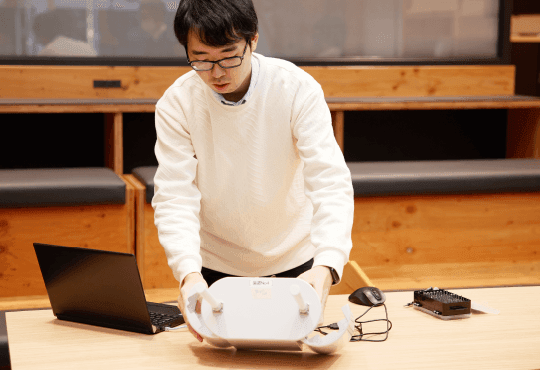
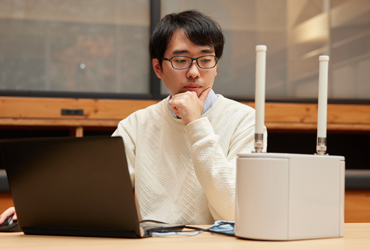
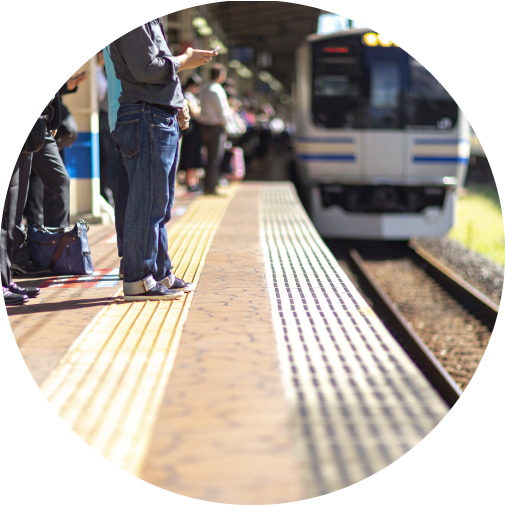

― How do you think about sustainable development goals at work and in daily life?
We now hear about sustainable development goals daily on TV, radio, and the internet. At first, I simply thought of these as only eco-friendly approaches. However, as my understanding of the connection between sustainable development and transportation infrastructure increased through my work, and I gradually realized that sustainable development goals are connected to a wide range of issues, including those closely related to industry, city development, and health. Understanding the meaning of business from a broad perspective rather than from environmental issues alone changes our awareness of and approaches to sustainable development.
Although I am engaged in research on autonomous driving, I take trains more often than I drive. This has been true for a long time, and it’s not because I am thinking about CO2 emissions. It’s simply a habit I got into a long time ago. I’m happy, though, that my behavior is something that helps achieve a more sustainable society. When I see my mother saving leftover vegetables for soup, I now think that such small things lead contribute to sustainability as well.

Accelerating the use of I2X roadside units to realize a safer society
― What kind of sustainable development activities do you think young people (Millennials or Gen Z) would like companies to work on?
I feel that sustainable development has become a keyword that increases awareness of sustainability in my generation. When I go shopping, I choose products that are more eco-friendly. Different from individuals, I would like companies to find connections with sustainable development in existing economic activities and publicize the content. Especially focusing on Gen Z, communicating the company’s approaches to sustainable development via social media will be effective to let them know about the company and its approaches to these critical issues.
― What areas of sustainable development do you think Kyocera is uniquely able to help solve?
One of Kyocera’s strengths is its broad range of business segments. These include telecommunications, which I’m involved in, as well as electronic components, energy, healthcare, lifestyle products, and systems. By combining the telecommunication and healthcare segments, for example, we increase the potential for generating new services. Such a broad range of Kyocera businesses have great potential for harmonizing our lives with nature and making our society more prosperous.


― This is your second year at Kyocera. What is the most satisfying aspect of your work?
Regardless of experience level, Kyocera gives us the chance to pursue our areas of interest. Because I studied AI at university, I didn’t have much experience with wireless units. Immediately after joining Kyocera, I said that I wanted to get some practical experience with wireless units by working on demonstration experiments. In autumn of that year, I was assigned to help with field tests. Since then, I have taken extended business trips for on-site tests every two or three months. In addition to what I learn from senior staff at work, on-the-job training is great as well.
― What are your department’s sustainable development goals?
I2X roadside units are not yet common in Japan. In order to provide access to safe, affordable, accessible, and sustainable transport systems for everyone, we are focusing on increasing the practicality of I2X roadside units by solving a wide range of issues, from technical issues to issues surrounding installation, environment, and costs. We not only seek the use of the units for public transportation and communication with passenger cars, but also to link units with smartphones and wearable devices, which we believe will bring us closer to the realization of city development where people and vehicles can move around safely and securely.
Kyocera's initiatives for the future
Self-Driving Demonstration Tests on Public Roads
Kyocera Corporation performed a joint self-driving demonstration test with Advanced Smart Mobility Co., Ltd. on a section of public road between Kyocera's Shiga Gamo and Shiga Yokaichi Plants (approximately 1 km). The test vehicle was a 31-seat, 7-meter-long J6 compact electric bus from BYD Company Ltd., which underwent a self-driving Level 2 test that involved self-driving while manned at all times. Looking forward, we hope to support the adoption of safe, secure public transit by linking buses with roadside units to share real-time information on areas with blind spots - including object recognition to locate pedestrians and other vehicles, as well as traffic signal timing.
